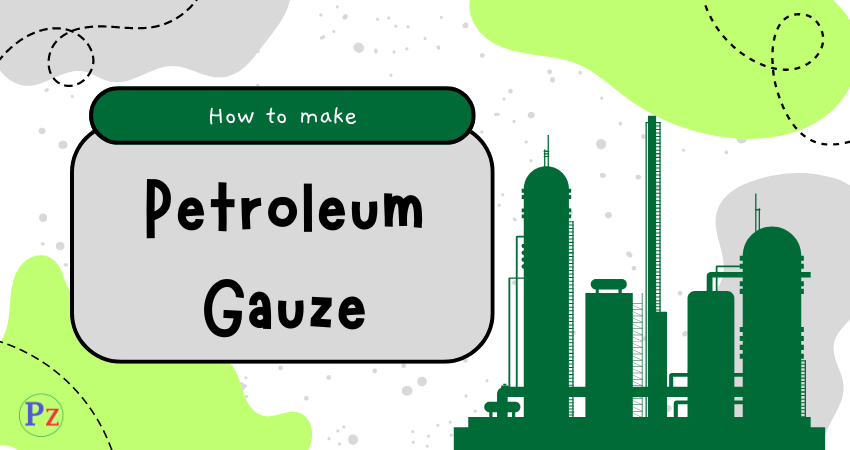Petroleum gauze is an essential tool in wound care, especially in medical settings. Whether you’re managing burns, cuts, or other injuries, this special type of dressing provides moisture retention while protecting the wound. But did you know you can actually make petroleum gauze at home? This guide will walk you through the materials, steps, and benefits of making your own petroleum gauze.

[sc_fs_faq html=”true” headline=”h2″ img=”” question=”What is Petroleum Gauze?” img_alt=”” css_class=””] Petroleum gauze is a type of medical dressing that is coated with a layer of petroleum jelly, also known as petrolatum. This non-adherent gauze is widely used in wound care to maintain a moist environment that aids in healing. [/sc_fs_faq]
Petrolatum vs. Petroleum
While the terms are often used interchangeably, petrolatum is the more refined and medical-grade version of petroleum jelly. It is safer for use on wounds, while regular petroleum jelly can sometimes contain impurities.
Non-Adherent Gauze
The key benefit of petroleum gauze is that it doesn’t stick to the wound, minimizing pain during dressing changes. This non-adherent quality makes it ideal for sensitive injuries, burns, and surgical wounds.
The History of Petroleum Gauze
Petroleum gauze was first developed in the early 20th century as a solution to promote faster healing and reduce pain during dressing changes. Over time, its usage expanded, and it became a staple in hospitals and first-aid kits worldwide.
Why Use Petroleum Gauze?
Petroleum gauze offers numerous medical benefits, including keeping the wound moist, which speeds up healing and reduces the risk of infection.
Moisture Retention and Wound Healing
Moisture is essential for healing, and petroleum gauze helps retain it. A moist wound environment prevents the formation of scabs, allowing new tissue to grow more effectively.
Reduced Pain on Removal
One of the main reasons petroleum gauze is so popular is its ability to minimize pain when removed. It prevents the dressing from adhering to the wound, making it easier to change without causing further damage.
Ingredients and Materials Needed to Make Petroleum Gauze
To make petroleum gauze at home, you will need a few basic materials:
Gauze Pads: These can be purchased from any pharmacy or medical supply store. Ensure they are sterile and high-quality.
Petroleum Jelly: Choose a medical-grade petroleum jelly, like Vaseline, to coat the gauze.
Sterilization Equipment: You’ll need a method to sterilize both your materials and the area in which you’re working to avoid contamination.
Step-by-Step Guide on How to Make Petroleum Gauze at Home
Step 1: Gather Your Materials
Before you start, gather all your materials, including gauze pads, petroleum jelly, and sterilization tools. Make sure everything is laid out in a clean, sterile environment.
Step 2: Sterilize the Gauze
Place the gauze pads in a sterilization chamber or boil them for a few minutes to eliminate any bacteria or impurities.
Step 3: Coat the Gauze with Petroleum
Take your sterilized gauze and apply a generous amount of petroleum jelly to one side. Make sure the entire surface is covered.
Step 4: Ensure Even Distribution
Use a clean tool or gloves to ensure the petroleum is evenly spread across the gauze. This prevents dry spots that could stick to the wound.
Step 5: Store Properly
Once coated, place the petroleum gauze in a sterile, airtight container. This will keep it fresh and ready for use.
Sterilization and Storage Tips
Sterilization Techniques for Homemade Gauze
Using boiling water or a steam sterilizer is the most common method for sterilizing gauze. Make sure to handle the sterilized materials with care to avoid contamination.
Best Practices for Safe Storage
Store your petroleum in an airtight, sterile container. If properly stored, it can last for several months.
Common Mistakes to Avoid
Insufficient Coating: If the gauze isn’t properly coated, it can stick to the wound, causing pain and delaying healing.
Overuse of Petroleum: Using too much petroleum jelly can prevent the wound from breathing, slowing down the healing process.
Contamination Risks: Always ensure that your materials and work environment are sterile. Contaminated gauze can lead to infections.
| Read More Topics |
| How does hydrogen water bottle work? |
| What is a cathodic IPS system? |
| A balanced chemical reaction obeys the law of responses |





